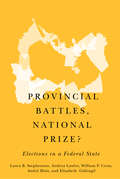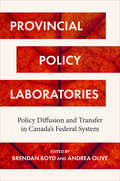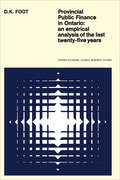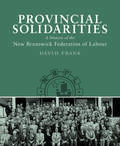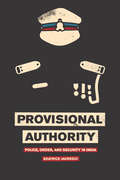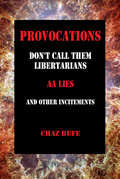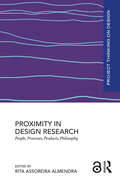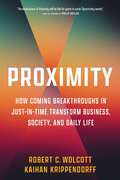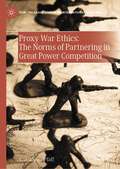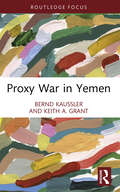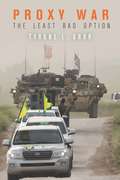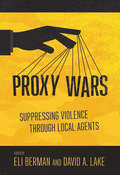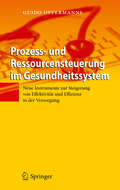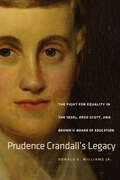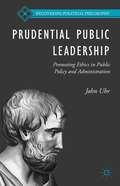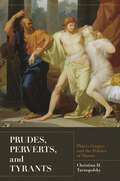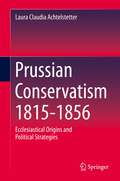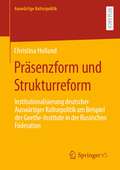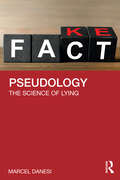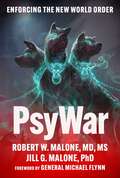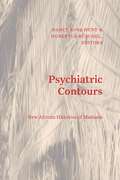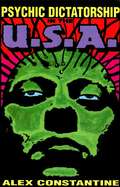- Table View
- List View
Provincial Battles, National Prize?: Elections in a Federal State
by André Blais William P. Cross Elisabeth Gidengil Andrea Lawlor Laura B. StephensonIn parliamentary systems like Canada, voters directly contribute to the election outcome only in their own riding. However, the focus of election campaigns is often national, emphasizing the leader rather than the local candidate, and national rather than regional polls. This suggests that elections are national contests, but election outcomes clearly demonstrate that support for parties varies strongly by province. Focusing on the 2015 Canadian election campaigns in British Columbia, Ontario, and Quebec, three large provinces with different subnational party systems, Provincial Battles, National Prize? evaluates whether we should understand elections in Canada as national wars or individual provincial clashes. The authors draw upon voter and candidate surveys, party campaign behaviour, and media coverage of the election to document how political parties vary their messages and strategies across provinces, how the media communicate and frame those messages, and how voters ultimately respond. The study shows that provincial variations in party support reflect differences in voters' political preferences rather than differences in party messages or media coverage. A novel and comprehensive study, Provincial Battles, National Prize? is the first and only thorough treatment of the party, media, and voter aspects of a federal election campaign through a subnational lens.
Provincial Policy Laboratories: Policy Diffusion and Transfer in Canada’s Federal System
by Brendan Boyd and Andrea OliveCanada's federal system, composed of ten provincial governments and three territories, all with varying economies and political cultures, is often blamed for the country's failure to develop coordinated policy responses to key issues. But in other federal and multi-level governance systems, the ability of multiple governments to test a variety of policy responses has been lauded as an effective way to build local and national policy. Despite high-profile examples of policy diffusion in Canada, there has been surprisingly little academic study of policy learning and diffusion among provinces. Featuring cutting-edge research, Provincial Policy Laboratories explores the cross-jurisdictional movement of policies among governments in Canada’s federal system. The book comprises case studies from a range of emerging policy areas, including parentage rights, hydraulic fracturing regulations, species at risk legislation, sales and aviation taxation, and marijuana regulation. Throughout, the contributors aim to increase knowledge about this understudied aspect of Canadian federalism and contribute to the practice of intergovernmental policymaking across the country.
Provincial Public Finance in Ontario: An Empirical Analysis of the Last Twenty-Five Years
by David FootThis detailed and informative study makes a timely contribution to a subject that has been the focus of much public discussion and debate in Ontario and elsewhere, namely the size and growth of the public sector. Working with the Public Accounts and other sources, Professor Foot offers both an historical account of, and an explanation for, the growth of provincial revenues and expenditures since the early 1950s. By concentrating on an analysis of the development of a single government over time, rather than adopting the traditional cross-section approach of analysing a number of junior-level governments. The study's conclusions are both informative and provocative. On the revenue side, a rate-base approach which separates discretionary from automatic changes in revenue determinants is shown to provide sufficient flexibility to accommodate the analysis and explanation of a wide range of specific revenues. On the expenditure side, the provincial government is found to adjust reasonably slowly to new levels of desired expenditures which appear to be determined primarily by demand variables. Of particular interest are findings which suggest that urbanization and elections have had little effect on expenditures and that available federal money has tended to be a substitute for provincial funds. In addition, the author notes that provincial expenditure patterns are consistent with either a revenue-led interpretation, where the recent availability of pension funds has stimulated expenditures, or a leading-sector interpretation, which implies a longer-run coordinated view of provincial public development. This study should stimulate a more informed discussion of the determinants and effects of provincial public finance in Ontario. It will appeal not only to those interested in the behaviour of junior-level governments but also to anyone interested in the size and growth of the public sector, in Ontario or elsewhere.
Provincial Solidarities: A History of the New Brunswick Federation of Labour
by David FrankEstablished in 1913, the New Brunswick Federation of Labour is the second oldest provincial federation of labour in Canada. Its history began in early campaigns for workers’ compensation and union recognition and continues today in the latest battles to defend social standards, secure employment, and union rights. Active initially in the port city of Saint John and the railway centre of Moncton, the federation soon expanded to include workers in the mines and mills of the north, taking up the causes of public employees and women workers and confronting the realities of life and work in a bilingual society. A pioneering study, written in clear and forceful prose, this is the untold story of provincial labour solidarities that succeeded in overcoming divisions and defeats to raise the status of working men and women within New Brunswick society. Drawing on archives, newspapers, and workers’ own descriptions of their experiences, Frank makes an original contribution to our understanding of the political, economic, and social development of the province. In so doing, he helps meet the need for an informed public awareness of the history of workers and unions in all parts of Canada.
Proving Damages to the Jury
by Jim WrenBig damage awards don't just happen. You need a plan for success. Any lawyer who has tried a damages case has experienced the quandary: What damage number do I give the jury? Is it enough? Is it too much? How do I ask for it? How do I support it? To give your clients justice, you need something more than a "hit or miss / hope and go" approach to damages. You need an intelligent damages strategy that encompasses every phase of the litigation and trial. Proving Damages to the Jury gives you that strategy. Relying on a solid foundation of current jury science research and more than 30 years of courtroom experience, author Jim Wren walks you through every step of your damages case, from the initial screening of a potential client to closing argument at trial. These abbreviated excerpts are just a sampling of what you will learn: Before Trial Discovery Develop a discovery plan to support your complete damages story. Take video depositions of your damage fact witnesses. Set up damage issues with requests for admission. Challenge the defense medical expert Visuals Use the seven stages of your damage story as the organizing principle for your visual strategy. Translate your damage story into visuals by working through these ten key questions: Enhance your credibility by making "verifiable proof" a focal point of your visual strategy. At Trial Voir Dire Raise the issue of frivolous lawsuits. Address jurors' reluctance to award damages for unintentional conduct. Plan the sequence of your questions. Opening Statement Focus on choices, rather than results, in presenting damages. Start with the question for the jury. Help jurors understand the significance of their role. Cross-Examination Understand what makes cross examination powerful. Use "you can understand" questions to validate the consequences of the plaintiff's injury. Encourage juror anger as a motivator for damages. Closing Argument Provide guidance for intangible damages. Help jurors make a significant difference.
Provisional Authority: Police, Order, and Security in India
by Beatrice JaureguiPolicing as a global form is often fraught with excessive violence, corruption, and even criminalization. These sorts of problems are especially omnipresent in postcolonial nations such as India, where Beatrice Jauregui has spent several years studying the day-to-day lives of police officers in its most populous state, Uttar Pradesh. In this book, she offers an empirically rich and theoretically innovative look at the great puzzle of police authority in contemporary India and its relationship to social order, democratic governance, and security. Jauregui explores the paradoxical demands placed on Indian police, who are at once routinely charged with abuses of authority at the same time that they are asked to extend that authority into any number of both official and unofficial tasks. Her ethnography of their everyday life and work demonstrates that police authority is provisional in several senses: shifting across time and space, subject to the availability and movement of resources, and dependent upon shared moral codes and relentless instrumental demands. In the end, she shows that police authority in India is not simply a vulgar manifestation of raw power or the violence of law but, rather, a contingent and volatile social resource relied upon in different ways to help realize human needs and desires in a pluralistic, postcolonial democracy. Provocative and compelling, Provisional Authority provides a rare and disquieting look inside the world of police in India, and shines critical light on an institution fraught with moral, legal and political contradictions.
Provocations: Don't Call Them Libertarians, AA Lies, and Other Incitements
by Chaz BufeProvocations is a collection of Chaz Bufe's writings on anarchism, atheism, religion, Alcoholics Anonymous, political and religious cults, new age nuttiness, political and social repression in the United States, the phoniness of contemporary "libertarianism," and roads to change. The tone ranges from the serious and analytical to the sarcastic and darkly humorous in this wide-ranging exercise in critical thinking.
Proximity in Design Research: People, Processes, Products, Philosophy (Project Thinking on Design)
by Rita Assoreira AlmendraProximity in Design Research explores four constituents of design: people, processes, products and philosophy, and their potential to bridge contemporary gaps through multilevel synergies.The book brings together a variety of design approaches on several scales developed in the collaboration of different agencies and within diverse contexts. Proximity prompts us to explore the challenges and opportunities for research in design, with the widening and closing of distances in unpredictable times such as those during the COVID-19 pandemic. Despite the social distance imposed during this unprecedented global health scenario, researchers and professionals across different areas of knowledge have engaged in an extraordinary interdisciplinary and transdisciplinary global cooperation. This reinvented proximity enhanced the ability to cross fields, remove boundaries to collaboration between disciplines and accelerate processes towards an overarching goal: to overcome adversity. This edited collection reflects on what designers have taken from this experience so far and the possibilities that are foreseen as the concept of proximity is redefined.This book offers critical knowledge related to both design practice and design theory. It will be of interest to researchers, teachers and students working in the design disciplines.
Proximity: How Coming Breakthroughs in Just-in-Time Transform Business, Society, and Daily Life
by Kaihan Krippendorff Robert C. WolcottWhat if you could have whatever you want, produced and provided immediately and affordably no matter how customized—with minimal environmental impact? Products, services, and experiences on demand. Just-in-time anything, anywhere, anytime. This radical change is underway, as digital technologies push the production and provision of value ever closer to the moment of demand.Robert C. Wolcott and Kaihan Krippendorff provide an indispensable guide to the Proximity revolution, showing how it’s transforming every industry—and our lives. Offering unparalleled foresight for leaders and innovators, they reveal how pervasive this trend will be. Proximity represents an entirely new way to serve customers, with critical implications for corporate strategy, investing, public policy, supply chain resilience, and sustainability. Incremental changes to existing business models won’t suffice.Through interviews and compelling examples, Proximity shares stories of the people and companies leading the way. The book places rapidly advancing technologies—from generative AI and 3D printing to lab-grown meats, renewable energy, and virtual reality—in context and explores the factors accelerating the transformation.Proximity offers a playbook for business leaders, investors, and entrepreneurs to win this rapidly emerging game—and for each of us to consider the implications for our careers, families, communities, and lives.
Proxy War Ethics: The Norms of Partnering in Great Power Competition (Palgrave Studies in International Relations)
by C. Anthony PfaffWhile proxy relationships can be an effective means international actors use to transfer risk and lower their costs to compete, they also enable actors to circumvent international norms as well as create moral hazards that can make the practice self-defeating if not simply unethical. Applying the framework of the Just War Tradition, this book highlights some of these ethical gaps and addresses how proxy relationships introduce additional obligations for both sponsor and proxy. The author examines specific examples of how current precedents set a very high bar for accountability, and perversely incentivizes sponsors to employ proxies while discouraging any effort to moderate proxy behavior since that could imply effective control. In light of this, the book offers policy recommendations on how to best manage these relationships while maintaining certain moral commitments.
Proxy War in Yemen (Cass Military Studies)
by Keith A. Grant Bernd KausslerThis book analyzes the civil war in Yemen and how intervening external actors have shaped the trajectory of the conflict. The work examines the conflict in Yemen as a testing ground for expectations about the autonomy and control of proxies by external patrons and the direct consequences for civilian victimization and duration of war. Like other proxy wars, the international dimensions of the war made the conflict in Yemen subject to the geopolitical interests of intervening powers. The longstanding power rivalry between Saudi Arabia and Iran over Middle East supremacy resulted in a competitive intervention in Yemen, where the initial belligerents of the civil war—the Houthi and the Hadi regime—were used as proxies by Tehran and the Gulf coalition led by Riyadh, respectively. Their intervention ultimately translated into a prolonged and destructive conflict. The often contradictory and self-interested patronage strategies by the coalition’s two central patrons, Saudi Arabia and the United Arab Emirates, undermined their broader goal of containing Iran. However, Iran’s support for the Houthis enabled them to bait and bleed the Gulf coalition. Lastly, in an effort to balance against Iran, the United States underwrote the military campaign of the Gulf states with military hardware and personnel, thereby further prolonging the conflict and humanitarian disaster. This book concludes that intervention by external patrons both protracted the civil war and made it far more destructive for the civilian population. This book will be of much interest to students of proxy wars, Middle Eastern conflict, and security studies in general.
Proxy War: The Least Bad Option
by Tyrone L. GrohThe U.S. has indirectly intervened in international conflicts on a relatively large scale for decades. Yet little is known about the immediate usefulness or long-term effectiveness of contemporary proxy warfare. In cases when neither direct involvement nor total disengagement are viable, proxy warfare is often the best option, or, rather, the least bad option. Tyrone L. Groh describes the hazards and undesirable aspects of this strategy, as well as how to deploy it effectively. Proxy War explores the circumstances under which indirect warfare works best, how to evaluate it as a policy option, and the possible risks and rewards. Groh offers a fresh look at this strategy, using uncommon and understudied cases to test the concepts presented. These ten case studies investigate and illustrate the different types and uses of proxy war under varying conditions. What arises is a complete theoretical model of proxy warfare that can be applied to a wide range of situations. Proxy war is here to stay and will likely become more common as players on the international stage increasingly challenge U.S. dominance, making it more important than ever to understand how and when to deploy it.
Proxy Wars: Suppressing Violence through Local Agents
The most common image of world politics involves states negotiating, cooperating, or sometimes fighting with one another; billiard balls in motion on a global pool table. Yet working through local proxies or agents, through what Eli Berman and David A. Lake call a strategy of "indirect control," has always been a central tool of foreign policy. Understanding how countries motivate local allies to act in sometimes costly ways, and when and how that strategy succeeds, is essential to effective foreign policy in today's world. In this splendid collection, Berman and Lake apply a variant of principal-agent theory in which the alignment of interests or objectives between a powerful state and a local proxy is central. Through analysis of nine detailed cases, Proxy Wars finds that: when principals use rewards and punishments tailored to the agent's domestic politics, proxies typically comply with their wishes; when the threat to the principal or the costs to the agent increase, the principal responds with higher-powered incentives and the proxy responds with greater effort; if interests diverge too much, the principal must either take direct action or admit that indirect control is unworkable. Covering events from Denmark under the Nazis to the Korean War to contemporary Afghanistan, and much in between, the chapters in Proxy Wars engage many disciplines and will suit classes taught in political science, economics, international relations, security studies, and much more.
Prozess- und Ressourcensteuerung im Gesundheitssystem
by Guido OffermannsIn dem Buch werden aktuelle Fragen der Steuerung im Gesundheitssystem thematisiert. Ein Bezugsrahmen für notwendige Veränderungen wird beschrieben und daraus Anforderungen an ein modernes Krankenhausmanagement abgeleitet. Zudem wird die Wirksamkeit unterschiedlicher Qualitätsmodelle untersucht und ein Konzept zur Entwicklung von Gesundheitszielen mit Blick auf Prävention und Gesundheitsförderung geliefert. Leitmotiv ist hierbei die Steigerung der Wertschöpfung für Patienten sowie die Befähigung der Mitarbeiter, bestmögliche Qualität zu bieten.
Prudence Crandall's Legacy: The Fight for Equality in the 1830s, Dred Scott, and Brown v. Board of Education (The Driftless Connecticut Series)
by Donald E. WilliamsThe &“compelling and lively&” story of a pioneering abolitionist schoolteacher and her far-reaching influence on civil rights and American law (Richard S. Newman, author of Freedom&’s Prophet). When Prudence Crandall, a Canterbury, Connecticut schoolteacher, accepted a black woman as a student, she unleashed a storm of controversy that catapulted her to national notoriety, and drew the attention of the most significant pro- and anti-slavery activists of the early nineteenth century. The Connecticut state legislature passed its infamous Black Law in an attempt to close down her school. Crandall was arrested and jailed—but her legal legacy had a lasting impact. Crandall v. State was the first full-throated civil rights case in U.S. history. The arguments by attorneys in Crandall played a role in two of the most fateful Supreme Court decisions, Dred Scott v. Sandford, and the landmark case of Brown v. Board of Education. In this book, author and lawyer Donald E. Williams Jr. marshals a wealth of detail concerning the life and work of Prudence Crandall, her unique role in the fight for civil rights, and her influence on legal arguments for equality in America that, in the words of Brown v. Board attorney Jack Greenberg, &“serves to remind us once more about how close in time America is to the darkest days of our history.&” &“The book offers substantive and well-rounded portraits of abolitionists, colonizationists, and opponents of black equality―portraits that really dig beneath the surface to explain the individuals&’ motivations, weaknesses, politics, and life paths.&” ―The New England Quarterly &“Taking readers from Connecticut schoolrooms to the highest court in the land, [Williams] gives us heroes and villains, triumph and tragedy, equity and injustice on the rough road to full freedom.&” —Richard S. Newman, author of Freedom&’s Prophet
Prudential Public Leadership
by John UhrDemocratic systems of public administration draw on various schools of political leadership to promote administrative ethics and public responsibility. Contemporary public administrators justify their public leadership through a blend of ethics around pragmatism (Mill's utilitarianism), principle (Kant's deontology or duty-based ethics) and prudence (Aristotle's ethical and political theory). Prudential Public Leadership brings Aristotle back into the front rank of studies of administrative leadership, based in part on the now-neglected reliance on Aristotle by the innovators who shaped the system of democratic public administration in the late nineteenth century.
Prudes, Perverts, and Tyrants: Plato's Gorgias and the Politics of Shame
by Christina H. TarnopolskyIn recent years, most political theorists have agreed that shame shouldn't play any role in democratic politics because it threatens the mutual respect necessary for participation and deliberation. But Christina Tarnopolsky argues that not every kind of shame hurts democracy. In fact, she makes a powerful case that there is a form of shame essential to any critical, moderate, and self-reflexive democratic practice. Through a careful study of Plato's Gorgias, Tarnopolsky shows that contemporary conceptions of shame are far too narrow. For Plato, three kinds of shame and shaming practices were possible in democracies, and only one of these is similar to the form condemned by contemporary thinkers. Following Plato, Tarnopolsky develops an account of a different kind of shame, which she calls "respectful shame." This practice involves the painful but beneficial shaming of one's fellow citizens as part of the ongoing process of collective deliberation. And, as Tarnopolsky argues, this type of shame is just as important to contemporary democracy as it was to its ancient form. Tarnopolsky also challenges the view that the Gorgias inaugurates the problematic oppositions between emotion and reason, and rhetoric and philosophy. Instead, she shows that, for Plato, rationality and emotion belong together, and she argues that political science and democratic theory are impoverished when they relegate the study of emotions such as shame to other disciplines.
Prussian Conservatism 1815-1856: Ecclesiastical Origins and Political Strategies
by Laura Claudia AchtelstetterThe book examines the nexus between political and religious thought within the Prussian old conservative milieu. It presents early-nineteenth-century Prussian conservatism as a phenomenon connected to a specific generation of young Prussians. The book introduces the ecclesial-political ‘party of the Evangelische Kirchenzeitung’ (EKZ), a religious party within the Prussian state church, as the origins of Prussia’s conservative party post-1848. It traces the roots of the EKZ party back to the experiences of the Napoleonic Wars (1806-15) and the social movements dominant at that time. Additionally, the book analyses this generation’s increasing politicization and presents the German revolution of 1848 and the foundation of Prussia’s first conservative party as the result of a decade-long struggle for a religiously-motivated ideal of church, state, and society. The overall shift from church politics to state politics is key to understanding conservative policy post-1848. Consequently, this book shows how conservatives aimed to maintain Prussia’s character as a Christian and monarchical state, while at the same time adapting to contemporary political and social circumstances. Therefore, the book is a must-read for researchers, scholars, and students of Political Science and History interested in a better understanding of the origins and the evolution of Prussian conservatism, as well as the history of political thought.
Präsenzform und Strukturreform: Institutionalisierung deutscher Auswärtiger Kulturpolitik am Beispiel der Goethe-Institute in der Russischen Föderation (Auswärtige Kulturpolitik)
by Christina HollandDie Untersuchung will einen wissenschaftlichen Beitrag zum Thema deutsche Auswärtige Kulturpolitik im Allgemeinen leisten. Mit dem Schwerpunkt der Kulturinstitute des Goethe-Instituts im Ausland wird ein Thema in den Fokus gerückt, das bereits vielfach diskutiert worden ist, allerdings meist unter dem Aspekt der programmatischen Inhaltsanalyse und weniger unter dem Aspekt der Institutionalisierung. Christina Holland untersucht in diesem Buch die Auswärtige Kulturpolitik unter dem Blickwinkel der festen kulturellen Infrastruktur anhand einer SWOT-Analyse am Beispiel der Kulturinstitute des Goethe-Instituts in der Russischen Föderation.
Pseudo-Public Spaces in Chinese Shopping Malls: Rise, Publicness and Consequences (Routledge Complex Real Property Rights Series)
by Yiming WangShopping malls in China create a new pseudo-public urban space which is under the control of private or quasi-public power structure. As they are open for public use, mediated by the co-mingling of private property rights and public meanings of urban space, the rise, publicness and consequences of the boom in the construction of shopping malls raises major questions in spatial political economy and magnifies existing theoretical debates between the natural and conventional schools of property rights. In examining these issues this book develops a theoretical framework starting with a critique of the socio-spatial debate between two influential bodies of work represented by the work of Henri Lefebvre and David Harvey. Drawing on the framework, the book examines why pseudo-public spaces have been growing so rapidly in China since the 1980s; assesses to what degree pseudo-public spaces are public, and how they affect the publicness of Chinese cities; and explores the consequences of their rise. Findings of this book provide insights that can help to better understand Chinese urbanism and also have the potential to inform urban policy in China. This book will be of interest to academics and researchers in both Chinese studies and urban studies.
Pseudology: The Science of Lying
by Marcel DanesiIn an age where fake news, conspiracy theories, and outright lies by political and cultural leaders are commonplace, we may be becoming accustomed to lying, or worse, even immune to it. Pseudology unravels the reasons for this by describing a “science of lying” that looks at various aspects of this trait, from how it affects the brain to how it distorts perception.Interest in lying goes back to antiquity and writing and debate has only increased in the present day, but what is missing is a treatment that synthesizes the work from linguists, political scientists, anthropologists, psychologists, neuroscientists, and sociologists, tying them to the philosophical and literary views of lying throughout history. Such a treatment can be called "pseudology": an interdisciplinary science for classifying, collating, and assessing ideas about lying. This book is a comprehensive treatment of pseudology, emphasising the importance of studying lying in our current climate. Pseudology addresses questions such as:• What is a lie?• Why do we lie?• Why are we so susceptible to lying?• How does lying activate false beliefs and generate hatred of others?• How has lying shaped the course of history (at least to some extent)?• How has lying been adopted as a basic thematic element in literature and the arts?Synthesising research from a broad range of disciplines and from the perspective of a leading cognitive linguist, this text weaves ideas and theories about lying cohesively into an overall interdisciplinary science. This landmark book is vital for students and scholars of language as well as anyone interested in politics, sociology, or psychology.
PsyWar: Enforcing the New World Order
by Robert W. Malone Jill Glasspool MalonePsyWar: Enforcing the New World Order exposes the history and tactics of modern psychological warfare on the American people and offers a way forward for citizens to resist totalitarian control. PsyWar is when a government coordinates and directs deployment of propaganda, censorship, and psychological operations (psyops) tools in campaigns designed to manipulate public opinion. The authors address critical topics including: Propaganda and Behavioral Control Psychological Bioterrorism Deep State Censorship Surveillance Capitalism Administrative State Objectives Fifth-Generation Warfare PsyWar Tactics Techno-Totalitarianism The New World Order and Global Control Free speech is the most pragmatic tool we have for ascertaining truth. Only by examining all sides of an issue can the truth be chiseled out like a statue out of marble. We must defend all speech—whether untrue, hateful, or intolerable, as that is the only way to protect our right to understand the world. As soon as free speech is restricted, that restriction will be used to sway public opinion. Now is a time when America needs hope. But more than hope, we need to restore our Constitution and Bill of Rights as the foundational documents of our Republic. These documents support and protect our personal sovereignty and are at the core of our fundamental rights as Americans. We must work to make this country great again by restoring our commitment to these foundational principles and ethics.
Psychiatric Contours: New African Histories of Madness (Theory in Forms)
by Nancy Rose Hunt & Hubertus BüschelPsychiatric Contours investigates new histories of psychiatry, derangement, and agitated subjectivities in colonial and decolonizing Africa. The volume lets the multivalent term madness broaden perception, well beyond the psychiatric. Many chapters detect the mad or the psychiatric in unhinged persons, frantic collectives, and distressing situations. Others investigate individuals suffering from miscategorization. A key Foucauldian word, vivacity, illuminates how madness aligns with pathology, creativity, turbulence, and psychopolitics. The archives, patient-authored or not, speak to furies and fantasies inside asylums, colonial institutions, decolonizing missions, and slave ships. The frayed edges of politicized deliria open up the senses and optics of psychiatry’s history in Africa far beyond clinical spaces and classification. The volume also proposes fresh concepts, notably the vernacular, to suggest how to work with emic clues in a granular fashion and telescope the psychiatric within histories of madness. With chapters stretching across much of ex-British and ex-French colonial Africa, Psychiatric Contours attends to the words, autobiographies, and hallucinations of the stigmatized and afflicted as well as of the powerful. Expatriate psychiatrists with cameras, prying authorities, fearful missionaries, and colonial anthropologists enter these readings beside patients, asylums, and boarding schools via research on possession “hysteria” and schizophrenia. In brief, this book demonstrates novel ways of writing not only medical history but all subaltern and global histories.Contributors. Hubertus Büschel, Raphaël Gallien, Matthew M. Heaton, Richard Hölzl, Nancy Rose Hunt, Richard C. Keller, Sloan Mahone, Nana Osei Quarshie, Jonathan Sadowsky, Romain Tiquet
Psychiatric Encounters: Madness and Modernity in Yucatan, Mexico (Medical Anthropology)
by Beatriz M. Reyes-FosterPsychiatric Encounters presents an intimate portrait of a public inpatient psychiatric facility in the Southeastern state of Yucatan, Mexico. The book explores the experiences of patients and psychiatrists as they navigate the challenges of public psychiatric care in Mexico. While international reports condemning conditions in Mexican psychiatric institutions abound, Psychiatric Encounters considers the large- and small-scale obstacles to quality care encountered by doctors and patients alike as they struggle to live and act like human beings under inhumane conditions. Beatriz Mireya Reyes-Foster closely examines the impact of the Mexican state’s neoliberal health reforms on how patients access care and doctors perform their duties. Engaging with madness, modernity, and identity, Psychiatric Encounters considers the enduring role of colonialism in the context of Mexico's troubled contemporary mental health care institutions.
Psychic Dictatorship in the U.S.A.
by Alex ConstantineBombing minds rather than bodies is the warfare of the new millennium. This book uncovers the terrifying extent of electromagnetic and biotelemetric mind control experimentation on involuntary human subjects."The evidence presented in this book is a savage indictment of democracy-turned-dictatorship. The sordid truth about what really goes on in the halls of power is often too much to take, but it does help to have some idea of what we're up against." -- Nexus
